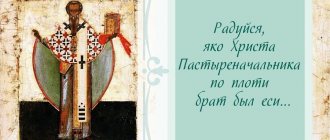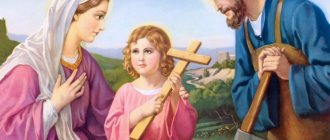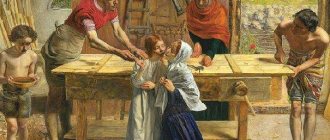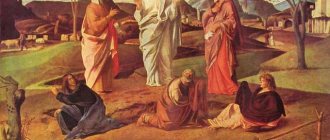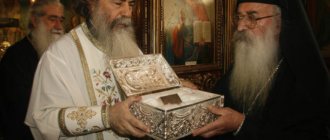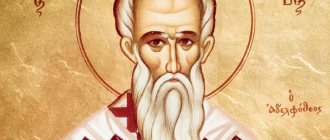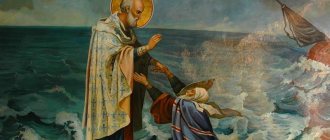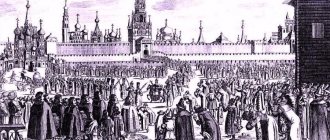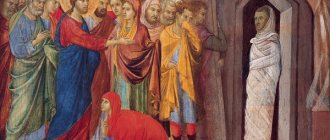Vocation
Jacob was the son of the Galilean fisherman Zebedee and Salome, the daughter of Joseph the Betrothed. Together with his younger brother, the future evangelist John the Theologian, Jacob helped his father in his fishing on Lake Gennesaret.
One day, when Jesus Christ was passing by the shore of a lake, “He saw James Zebedee and John his brother also in a boat mending nets, and immediately called them. And they, leaving their father Zebedee in the boat with the workers, followed Him” (Mark 1:19-20).
From that time on, they were no longer separated from the Lord, and both were chosen to be among the 12. Because of their impetuous and decisive character, Jesus called the brothers “Boanerges,” which translated from Aramaic meant “sons of thunder” (Mark 3:17). In church literature, James Zebedee is often called James the Elder to distinguish him from the Apostle James Alphaeus and James the Brother of the Lord, or James the Younger.
Apostle James Zebedee, Byzantium, XIII century.
Together with the Apostle Peter, the brothers were the closest disciples of the Lord. They witnessed the resurrection of Jairus' daughter. Only they Jesus made witnesses of His Transfiguration, when on Mount Tabor appeared before them in white robes. They accompanied the Lord in the Garden of Gethsemane on the anxious night before He was taken into custody.
Jacob, brother of the Lord
According to the most common version, first clearly stated by Bishop Epiphanius of Cyprus (IV century), Jacob was the eldest son of the righteous Joseph the Betrothed, born in his first marriage. The Gospels repeatedly mention “the brothers and sisters of Jesus,” and the evangelists Mark and Matthew even give names: James, Josiah, Judas and Simon. From the point of view of Saint Epiphanius, these are precisely the children of Joseph the Betrothed, who remained with their father even after he became engaged to the Virgin Mary and, probably, were close to Jesus in His childhood.
This point of view can also be supported by the Protoevangelium of James - an apocrypha (a text dedicated to certain events and persons of sacred and church history, which the Church did not include in the canon of Holy Scripture - Ed.), telling about the Nativity of the Blessed Virgin Mary, Her introduction to the Jerusalem Temple and the events preceding the Nativity of the Savior. From the text of this Proto-Gospel it follows that its author, Jacob, was hiding in the desert when the Jewish king Herod sought to kill the baby Jesus; obviously - he was hiding along with the entire family of Joseph and the Virgin Mary, who, as we know, fled to Egypt for several years (cf.: Matt. 2:13–15).
Apostle James Emmanuel Tzane Mpunialis, 1683. Collection of the Museum of Icons. Venice
But there is another point of view: James and the other “brothers of the Lord” were cousins of Jesus. This version was defended by Blessed Jerome of Stridon, who lived in the second half of the 4th - early 5th centuries and traveled a lot around the Holy Land. He expressed his thought in a dispute with Helvidius, who believed that the “brothers of the Lord” are His own brothers, the youngest children of Mary and Joseph, born after Jesus (some Protestants still believe this today). Jerome drew attention to the fact that in the 15th chapter of the Gospel of Mark Mary, the mother of James the less and Josiah, is mentioned, and in the other Gospels there is a certain “Mary of Jacob.” Moreover, the Gospel of John says that the Mother of God had a sister, Mary of Cleophas (John 19:25 ). Probably, Blessed Jerome suggested, James, Josiah, Simon and Judas were the sons of the Mother of God’s sister and, therefore, cousins of the Lord Himself. With this understanding, the Apostle James, “brother of the Lord,” merges into one person with James Alpheus, one of the 12 apostles who were part of the inner circle.
If Blessed Jerome is right, then James and his three brothers were related by blood to the Lord Jesus.
In those years when Christ walked the land of Palestine and preached, the brothers did not believe in Him, says the Apostle and Evangelist John (John 7 :5). Perhaps they were among those very neighbors about whom the Gospel reports that during the preaching of Jesus they tried to take Him home, for they said that He had lost His temper (Mark 3:21 ). But obviously, the Resurrection of Christ convinced the brothers that He called Himself the Son of God not without reason. The Apostle James was definitely convinced of this; it was not for nothing that he was among the few to whom Christ appeared shortly after His Resurrection (the Apostle Paul talks about this in the First Epistle to the Corinthians, 15 :7). And in the book of the Acts of the Holy Apostles, which tells about the life of the first Christian communities, we already meet with the believer Jacob, who heads the Christian community of Jerusalem and is a kind of arbiter in disputes that arose in the early Christian community. It is Jacob, for example, who has the last, most weighty word in the discussion about the conditions under which former pagans should be baptized in the provinces of Asia Minor. Under the influence of his authority, the Apostolic Council decides not to make it difficult for the Gentiles to turn to God, but to write to them that they should abstain from what is defiled by idols, from fornication, strangulation and blood, and that they do not do to others what they do not want for themselves (Acts 15 :19- 20).
“Saint Joseph with the Christ Child in His Arms” by Guido Reni. Around 1635
Church tradition has preserved for Jacob, the brother of the Lord, the name James the Righteous: he strictly observed the provisions of the Old Testament law, never drank wine and was generally a very abstinent person - and all this was combined in him with the belief that Jesus Christ is the true Son of God.
The Apostle Paul, who spent most of his time on missionary travels around the Mediterranean, returned to Jerusalem in short intervals between them and saw, as he himself says in the Epistle to the Galatians, the pillars of the Church - the apostles Peter, John and James (Gal 2 :9). One might decide that we are talking here about James, the son of Zebedee, one of the 12 apostles and the brother of John the Theologian. Moreover, it was these three apostles (that is, Peter, James Zebedee and John) that Christ especially brought closer to Himself and took them where he did not call the others - to Tabor, where they saw the Transfiguration; to the upper room, where the Lord resurrected the dead girl; to the Garden of Gethsemane, where they saw Him praying until he sweated blood... But the first chapter of the same Epistle clearly states: the Apostle Paul saw James, the brother of the Lord, in Jerusalem (Gal 1:19 ). Whereas James, John's brother, was killed while Judea was ruled by Herod Agrippa (who himself died in 44): it was he who pronounced the death sentence on the apostle, incited by the Jewish elite. Paul, however, made his travels, according to biblical scholars, in later times, starting from the second half of the 40s.
Martyrdom of the Apostle James Tzortzzi (Zorzis) Phuka. Fresco. Athos (Dionysiatus). 1547
Church tradition associates the name of the Lord's brother James with the authorship of the Epistle of James, known, in particular, for the phrase Faith without works is dead (James 2:20 ), as well as one of the earliest rites of the Divine Liturgy. Jacob the Righteous accepted death in old age from the Jews, who threw him from the porch of the Jerusalem Temple for his testimony about Christ.
Martyrdom
On the day of Pentecost, Jacob, along with other disciples, was filled with the Holy Spirit and participated in the establishment of the first Christian communities. Almost all the apostles remained for some time in Jerusalem, gaining strength and wisdom. But Jacob, by his nature, could not wait. He went to Spain “to the ends of the earth” to preach the Gospel, and then returned to Jerusalem. He boldly and openly preached among the Jews that Jesus Christ is the true Messiah, the Savior of the world. He defeated experienced scribes and Pharisees in disputes; no one could resist the pressure and eloquence of the disciple of Christ.
Church of the Apostle James Zebedee in Moscow in Yakovoapostolsky Lane
Seeing the power of miracles and the teachings of the Apostle James and the complete failure of their plans, the Jews were able to convince King Herod Agrippa I, who then owned all of Judea, to begin a persecution of the Christian Church. The Acts of the Apostles says: “At that time King Herod lifted up his hands against some of the church to do them harm, and killed James the brother of John with the sword” (Acts 12:1-2). This happened in Jerusalem in 44. James Zebedee is the only apostle whose death is described on the pages of the New Testament.
Other “relatives” of Jesus Christ
In the Gospel there is a mention of the “brothers and sisters” of Jesus Christ: “Is not this the carpenter, the son of Marinus, the brother of James, Josiah, Judas and Simon? Are not His sisters here, between us? And they were offended because of Him.” (Mark 6:3). Most likely, it was the mentioned Judas who later became one of the 12 apostles whom Christ chose to teach and preach the Gospel after his Ascension (not to be confused with Judas Iscariot, who betrayed Christ). The name of His brother James is also mentioned here (not to be confused with the Apostle James from among the 12). The Gospel does not give us the exact number of “relatives” of Christ, nor does it speak about the degree of relationship.
Finding the relics and beginning of veneration
According to legend, after the martyrdom of the Apostle James, the faithful placed his remains in a small boat and set them sailing on the waves of the Mediterranean Sea. The boat sailed for a long time or a short time, but finally it sailed to Spain, where Jacob had preached earlier, at the mouth of the Ulya River.
In 813, the hermit monk Pelayo, who lived in this area, following the guiding star that appeared, discovered an ark containing the relics of the apostle.
At the end of the century, in 896–899, a small church was built on the site of the find. The settlement that arose near it was called Compostela (in Latin - Campus Stellae, “place marked with a star”).
Shell on the fence of the tomb with the relics of the Apostle James
From this time on, pan-European veneration of the Apostle James began and strengthened. Saint James, who miraculously helped Spanish soldiers during the battles with the Moors, became the recognized patron saint of Spain. As an apostle who, during his ministry, undertook a long journey from the Holy Land to Spain, he also began to be considered the patron saint of pilgrims.
Road of Saint James
Seekers of truth and adventure went to the western outskirts of Spain in ancient pre-Christian times. The earth was considered flat, and here, at the “end of the earth,” the sun disappeared every evening. Where? Why? How?
With the discovery of the relics of the Apostle James, the construction of the cathedral and the emergence of the city of Santiago de Compostela, the pilgrimage to the north-west of Spain acquired a new spiritual meaning and became second in importance, after the pilgrimage to the Holy Land.
Church of St. James in Jerusalem, the circle in front of the icon marks the place where the apostle's head fell during his execution
In the Middle Ages, the number of pilgrims traveling along the roads to Compostela was enormous. But over time, the black plague epidemic, which sharply reduced the population of Europe, and then the Reformation and political instability in the 16th century. led to a noticeable decline in the popularity of the pilgrimage route.
In the early 1980s, the number of pilgrims could be counted on one hand, but since then interest in the difficult trek has increased noticeably. Thus, in 1978 there were only 13 pilgrims, and in 2009 there were more than 145 thousand.
Compostela attracted pilgrims from all over Europe. Believers from France, Germany, Portugal, England, Ireland, Poland and other countries followed the Way of St. James. Since 1999, pilgrims from Russia and Ukraine have been spotted here.
The pilgrimage to Santiago was made at different times by the English king Edward I, the famous Catholic saint Francis of Assisi, the Flemish painter Jan van Eyck, Pope John Paul II, the Brazilian writer Paulo Coelho and many others.
John the Evangelist, icon of the early 16th century.
To receive a certificate of completion of the Way of St. James, a pilgrim must walk 100 km or ride a bicycle 200 km. Upon arrival in the city, the pilgrim presents a special document in the cathedral with marks made at points along the way, after which he receives a “Certificate of Compostela” written in Latin. When the day of remembrance of the Apostle James, July 25, falls on a Sunday, the Year of St. James is declared in Spain, and accordingly, church festivities in this year are especially solemn. The next such event will happen in 2021. The Way of St. James is one of the UNESCO World Heritage Sites.
Liturgy of the Apostle James
The apostle wrote the first sequence of the liturgy, which is called the Liturgy of the Apostle James. Until the 9th century it was served everywhere, but subsequently it was preserved only in the Jerusalem Church. In the 4th century, Saints Basil the Great and John Chrysostom shortened the Liturgy of the Apostle James, drawing up their rites on its basis, which we still use today. In Russia, the Liturgy of the Apostle James was unknown until the 20th century - it was first served at the Leningrad Theological Academy in 1970 on the day of memory of the Apostle, and it is still celebrated in several dioceses of the Russian Orthodox Church.
